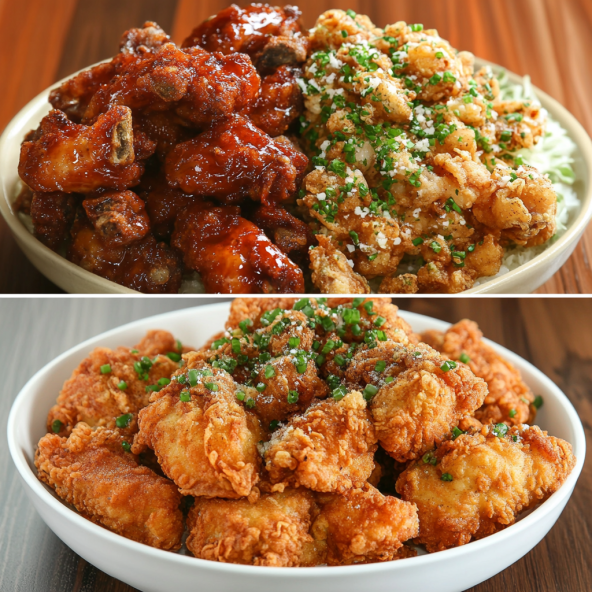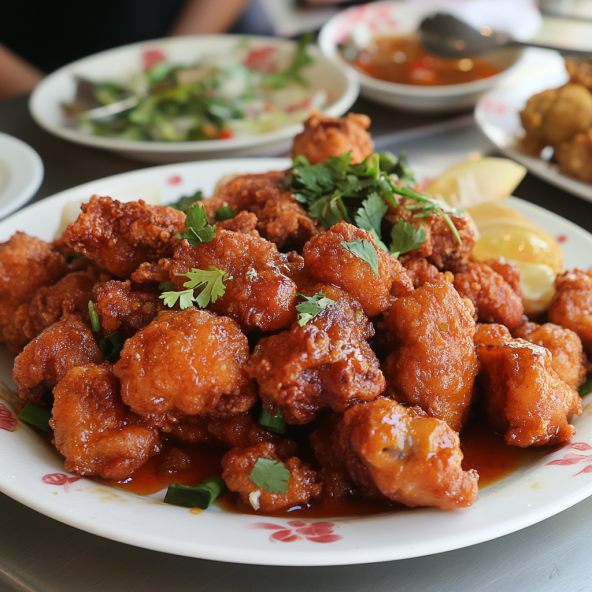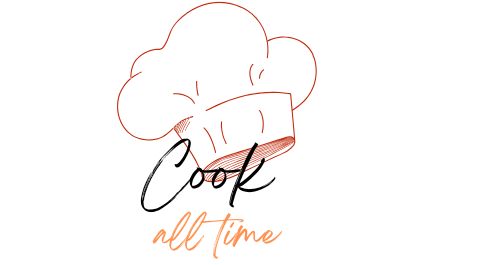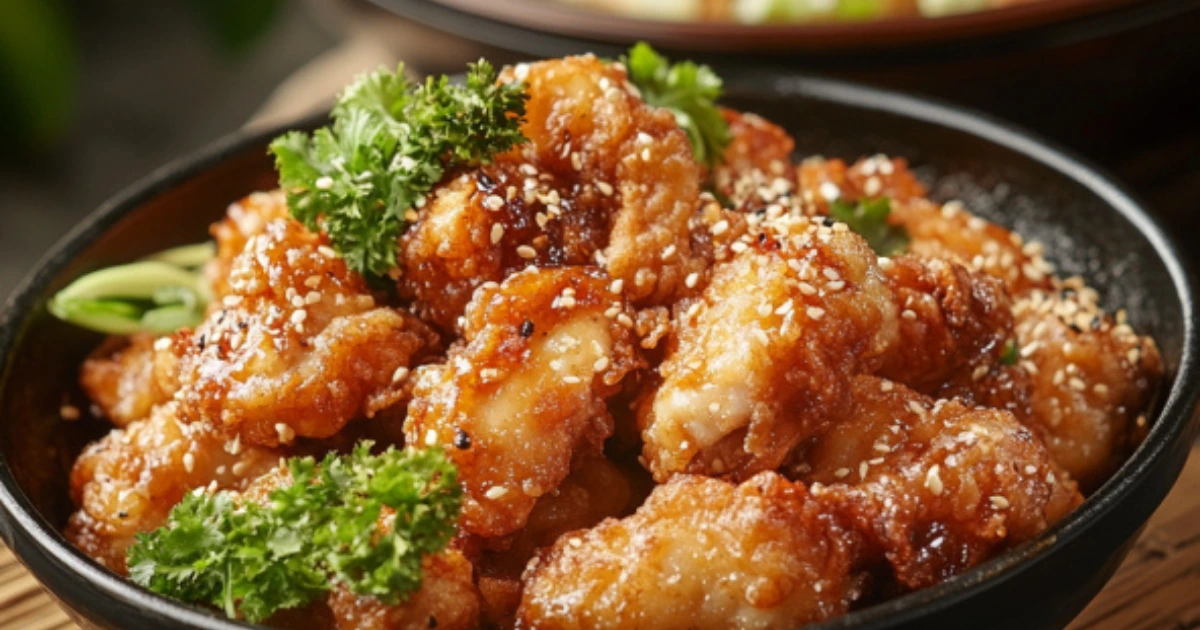Introduction
Diff Between Deep Fried Chicken and Fried Chicken ? Many popular dishes enjoyed worldwide use deep-fried as their base. So, what’s the difference between deep-fried and fried ? The deep-frying method creates crispy, golden-brown exteriors that perfectly complement the tender meat inside. Dishes like buffalo wings, nuggets, and tenders showcase the versatility of deep-fried chicken. Whether served as a party snack or a main course, deep-fried remains a favorite in various cuisines.
The difference between deep-fried chicken and Breaded chicken goes beyond terminology and involves factors like the type of oil used, cooking time, and how the chicken absorbs seasoning. Now, let’s delve into the specifics of these methods.
Table of Contents
What is Deep-Fried Chicken?
Deep-fried refers to the process of cooking chicken by completely submerging it in hot oil. This method allows the chicken to cook evenly, creating a crispy, golden brown coating. The process begins by heating the oil to temperatures between 350°F and 375°F (175°C – 190°C), and you immerse the chicken until it is fully cooked.
Typically, deep fryers are used for this method. They offer consistent heat and allow you to fry multiple pieces of chicken at once. As a result, the chicken has a crunchy exterior with tender, juicy meat inside. The deep-frying process locks in moisture, preventing the chicken from becoming dry. This technique is common in fast food chains and restaurants. It is known for its quick cooking times and crispy, uniform results..
What is Fried Chicken?
Generally refers to a broader category of frying techniques, such as pan-frying or shallow-frying. Unlike deep-frying, where the oil fully submerges the chicken, frying cooks the chicken with a smaller amount of oil. Typically, you cook the chicken in a skillet or deep pan, with the oil partially covering the chicken.
In traditional pan-frying, cooks usually use lower heat compared to deep-frying, and the cooking time varies depending on the size and thickness of the chicken. This method creates a less greasy texture than deep-frying but requires more attention to avoid burning or uneven cooking. Some variations of Breaded chicken involve breading the chicken in a seasoned flour mixture before frying, which enhances the flavor and creates a crispy texture.
Learn more about diverse fried chicken styles with Is Kennedy Fried Chicken the Same as Kentucky Fried Chicken?.
Key Differences
The key differences between deep-fried and Breaded lie in the equipment, oil usage, cooking time, and the final results.
- In deep-frying, cooks typically use a deep fryer, while in frying, they usually use a skillet or frying pan.
- Oil Usage: In deep-frying, the oil fully submerges the chicken, while in frying, the oil only partially covers the chicken.
- Cooking Time: Deep-frying generally cooks the chicken faster, as the hot oil surrounds the chicken, speeding up the cooking process. Pan-frying may take longer due to the lower heat and less oil.
- Results: Deep-fried results in a crispy coating that is more uniform, while fried may have a slightly less crisp texture but often provides a richer flavor due to the oil absorption.
Texture and Flavor Comparisons
When comparing the texture and flavor of deep-fried and Breaded, there are notable differences that can affect your choice of cooking method.

- Deep-Fried Chicken: Deep-frying creates an even, crispy texture all around the chicken, with the oil locking in moisture. The coating absorbs less oil than pan-Breaded chicken, making it crispier and crunchier. The flavor profile tends to focus on the seasoning in the breading, giving it a savory, seasoned taste.
- Fried Chicken: Pan-fried chicken, on the other hand, often has a thicker, more unevenly crispy coating. Due to the oil absorption, the exterior may feel heavier, but the inside remains juicy. The cooking method allows the chicken to absorb the flavors of the oil and any seasonings, resulting in a rich and flavorful bite.
Ultimately, both methods offer a satisfying crunch, but deep-fried is typically the go-to option for those who prioritize an extra crispy texture.
Health Considerations
Health-conscious eaters may wonder how deep-fried and fried compare nutritionally. Both methods involve cooking in oil, but there are some differences in the way the oil affects the final dish.
- Deep-Fried : Since hot oil submerges the chicken, it absorbs more oil, which increases its fat and calorie content. The high temperatures may also cause the formation of acrylamides, chemicals that can be harmful in large quantities.
- Fried : While pan-fried chicken absorbs less oil due to the shallower cooking method, it may still be high in fat depending on the type of oil used. However, pan-frying often results in a slightly lower oil absorption compared to deep-frying.
For a healthier option, consider baking or air-frying both types of chicken. These methods use less oil while still achieving a crispy result, though the texture may differ.
Cooking Times and Techniques
Understanding the cooking times and techniques for both deep-fried and Breaded can help ensure that you achieve the perfect results every time.
- Deep-Fried : When using a Intense fryer, heat oil to 350°F (175°C). Cooking time will vary based on the size of the chicken, but generally, it takes around 10-12 minutes for chicken pieces like wings or thighs. Always use a thermometer to check the internal temperature, which should reach 165°F (74°C).
- Fried Chicken: For pan-frying, heat about 1-2 inches of oil in a skillet over medium heat. The cooking time will depend on the size of the chicken pieces. Smaller pieces like wings may take 8-10 minutes per side, while larger pieces like breasts can take up to 15 minutes per side. Ensure the oil remains at a steady temperature to prevent burning.
In both cases, it’s essential to allow the chicken to rest for a few minutes after cooking to retain its juices.
Popular Dishes Using Deep-Fried Chicken
When considering the question, “What’s the difference between deep fried and fried?”, one key factor is how the methods impact popular dishes. Deep-fried lends itself well to dishes that require a crisp, uniform texture and quick cooking. Here are a few popular dishes using deep-fried :

- Buffalo Wings: These crispy wings typically undergo deep frying and then get coated in a spicy, tangy sauce. The crispy skin perfectly holds the sauce, making them a popular choice for game days or casual dining.
- Chicken Nuggets: Loved by both children and adults, chicken nuggets get deep-fried to create a crunchy exterior and tender, juicy interior.
- Chicken Tenders: Another deep-fried favorite, chicken tenders are breaded strips of chicken. They fry to a satisfying crunch with every bite.
These dishes rely on the deep-frying method for their signature crispy texture and quick cooking.
Popular Dishes Using Fried Chicken
In contrast, when it comes to Crispy chicken, the technique offers more versatility for creating hearty and flavorful dishes. Pan-frying or shallow-frying creates a crispy coating with a rich flavor. Here are some classic examples:
- Southern-Style Fried Chicken: Known for its crispy, well-seasoned exterior and juicy interior, this dish is a staple of Southern cuisine. The pan-frying method allows the chicken to slowly cook through while developing a golden, crunchy crust.
- Skillet Recipes: Skillet-fried chicken often involves cooking chicken pieces in a cast iron skillet. This method provides a crispy exterior, enhanced by the natural oils from the chicken, giving it a delicious, savory flavor.
The key difference between these dishes and those made with deep-fried lies in the flavor and texture. Crispy chicken often allows more seasoning to penetrate the meat, offering a richer taste.
Cultural Significance of Each Method
When exploring what’s the difference between deep-fried and fried , you must understand their cultural significance.. Each method holds distinct regional and historical importance.
- Deep-fried chicken is popular in fast food chains and casual dining, known for its crispy texture and quick cooking time. The deep-frying method became a staple in urban and commercial food settings where efficiency is key. It also appears more frequently in chain restaurants worldwide
- Fried Chicken: Pan-fried chicken, particularly Southern-style fried , holds deep cultural significance. In the Southern U.S., people cherish this dish, often passing it down through generations. The slower cooking method allows for rich flavor development and is typically used in home cooking, where people take their time and care.
Thus, people often associate deep-fried chicken with modern convenience, while Breaded chicken has historical roots in regional home cooking.
Which Method is Better for You?
Deciding between deep-fried and Crispy chicken depends on your priorities, such as convenience, flavor, and health considerations. Here’s a breakdown to help you decide:
- Convenience: Deep-frying is faster and allows for more pieces to be cooked at once. This method is ideal for quick meals or large gatherings.
- Flavor: Fried chicken often provides a richer, more flavorful taste. Since it absorbs less oil, you can enhance the flavor through marinades and seasonings.
- Health Benefits: If you’re concerned about calorie count, pan-fried chicken may be a better option as it absorbs less oil than deep-fried . However, you can make both methods healthier by using air fryers or opting for healthier oils
Overall, the best method depends on what you prioritize: convenience, flavor, or health.
Tools and Equipment Needed
Both deep-fried chicken and Crispy chicken require specific tools to ensure optimal results. Understanding the necessary equipment will improve your cooking experience and final outcome.
- Deep Fryer: Essential for deep-fried chicken, a deep fryer allows for consistent temperature control, making it easier to cook large batches evenly.
- Skillet or Frying Pan: For Breaded chicken, a cast-iron skillet or non-stick frying pan is ideal for achieving a golden, crispy exterior.
- Thermometer: Whether deep-frying or frying, using a cooking thermometer is essential to ensure your oil is at the right temperature (350°F-375°F for deep frying) and that the chicken reaches an internal temperature of 165°F for safe consumption.
These tools enhance both methods and ensure that you cook your chicken to perfection
Common Mistakes to Avoid
Even the most experienced cooks can encounter problems while deep-frying or frying chicken. To avoid issues, here are some common mistakes:
- Soggy Crust: One mistake is overcrowding the frying pan or deep fryer. Too much chicken at once can cause the temperature of the oil to drop, leading to a soggy crust. Make sure to cook in smaller batches.
- Uneven Cooking: When frying, especially in a pan, you must ensure the oil heats evenly. If some areas are too hot while others are too cool, the chicken will cook unevenly.. A thermometer can help monitor oil temperature.
- Not Draining Oil: After cooking, always let the chicken rest on paper towels to drain excess oil. This helps maintain a crispy crust and reduces unnecessary grease.
By avoiding these mistakes, you can enjoy perfectly fried or deep-fried every time.
FAQs About What’s the Diff Between Deep Fried Chicken and Fried Chicken ?
In this section, we address some common questions about deep-fried and fried to clear up any confusion.
- What’s the main difference between deep-fried chicken and Crispy chicken?
- Deep-fried chicken cooks by being submerged in oil, which creates a uniformly crispy exterior. In contrast, Breaded chicken cooks in a smaller amount of oil, typically in a pan, resulting in a slightly thicker crust and a richer flavor
- Which method is healthier?
- Breaded chicken tends to absorb less oil than deep-fried chicken, making it slightly healthier. However, using an air fryer or baking can be an even healthier option.
- Can I use the same seasoning for both?
- Yes, you can use the same seasonings for both methods. The difference lies in how the seasoning is absorbed and how the oil impacts the final flavor.
Conclusion
In conclusion, while what’s the difference between deep-fried chicken and fried chicken? ultimately comes down to technique and preference, both methods offer unique results. Deep-fried chicken tends to be crispier and quicker to prepare, while Crispy chicken offers a richer flavor and is more culturally tied to traditional home cooking.. By understanding the differences in cooking techniques, flavor, texture, and tools, you can choose the best method for your next chicken meal. Whether you’re in the mood for a crispy, golden coating or a flavorful, seasoned crust, both methods are sure to satisfy your cravings.


1 thought on “What’s the Diff Between Deep Fried Chicken and Fried Chicken?”